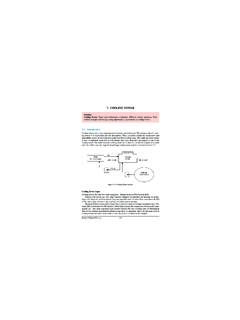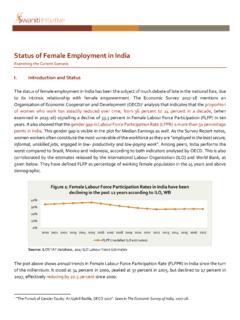Transcription of Energy Efficiency in Hospitals
1 Energy Efficiency in HospitalsBest Practice Guide Energy Efficiency in Hospitals Best Practice Guide March 2009 ABOUT ECO-III PROJECT Energy Conservation and Commercialization (ECO) Program was signed between the Government of India (GOI) and USAID in January 2000 under a Bilateral Agreement, with an objective to enhance commercial viability and performance of Indian Energy sector, and also to promote utilization of clean and Energy efficient technologies in the sector. Following the enactment of the Energy Conservation Act 2001, ECO-I Project supported GOI in the establishment of the Bureau of Energy Efficiency (BEE). Support to BEE was provided to set up procedures and authorities, establish office facilities and assist in several activities leading to the development of BEE s Action Plan including thrust area such as the development of an Energy auditor certification program. ECO-II Project provided BEE with necessary technical assistance and training support to implement two thrust areas of the Action Plan.
2 First was to develop the Energy Conservation Building Codes (ECBC) for the five climatic regions of India, and the second was to support Maharashtra Energy Development Agency in developing strategies for Energy conservation and implementation of selected programs. The major objective of the on going ECO-III Project Program is to assist BEE in the implementation of the Energy Conservation Act. The focus areas include the development of Energy Conservation Action Plan at the State level, implementation of the Energy Conservation Building Code, improvement of Energy Efficiency in existing buildings and municipalities, inclusion of Energy Efficiency subjects in architectural curriculum, enhancement of Energy Efficiency in small and medium enterprises, etc. Since November2006, International Resources Group (IRG) with support from its partners (IRG Systems South Asia, Alliance to Save Energy and DSCL Energy Services) has been implementing ECO-III Project by working closely with BEE, Gujarat Energy Development Agency, Punjab Energy Development Agency, international experts, academic institutions, and private sector companies.
3 Foreword Hospitals are the backbone of the health care delivery system in India. Until early 1980s, the Government run Hospitals and those operated by charitable organizations were the main providers of health care facilities. However in the 1980s and thereafter the sector has been attracting private capital in setting up Hospitals and nursing homes. According to a World Health Organization study, currently India has approximately 860 beds per million population, which is only one fifth of the world average of 3960. It has been estimated that with growing population and health care needs, 450,000 additional hospital beds will be required by 2010. Large corporate groups and charitable organizations have brought private finance and these resources are being invested in developing health infrastructure and modern equipments and technologies leading to the availability of super-specialty Hospitals across the country, especially in big cities.
4 However these developments have led to higher Energy -intensiveness in the hospital sector in India. Many modern Hospitals may consume ten to fifteen times more Energy per bed as compared to a typical government hospital, and this trend is likely to strain India s power sector substantially in the coming years. In fact, many Hospitals have been relying heavily on diesel power generation to keep the hospital s critical facilities running in the absence of reliable power supply from the Utilities. Sample studies in hospital sector have shown number of cost effective Energy conservation opportunities, which have remained untapped due to several reasons. The major barriers have been low awareness among the management of the Hospitals and limited availability of in-house expertise to identify and implement Energy saving projects. Good Energy management structure can bring in not only an Energy efficient culture within the hospital but also provide substantial reduction in Energy expenses without compromising on the quality of health care facilities to the patients.
5 This Energy Efficiency Guide has been prepared to address these issues, and is expected to raise the level of awareness on Energy Efficiency among the hospital administrators and managers and inspire them to initiate and implement Energy conservation program in their facilities. I would like to thank USAID especially Mr. S. Padmanaban and Ms. Archana Walia, in the development of this Guide under the ECO-III Project. I would also like place on record my appreciation for the ECO-III Project Team comprising of Dr. Satish Kumar and Mr. Ravi Kapoor for their valuable efforts in compilation and analysis of various Energy Efficiency issues keeping in view the prevailing perspectives of the management of Hospitals in India. I also appreciate DSCL for providing support to ECO-III Team in this task. I am confident this Guide will serve as a valuable reference on Energy Efficiency for both the existing Hospitals as well as the new Hospitals which are likely to come up in the next couple of years, and look forward to receiving their valuable comments and suggestions to further enrich the quality of this publication.
6 Date: 27th February, 2009 (Ajay Mathur) ACKNOWLEDGEMENTS This document has been developed by International Resource Group under USAID ECO-III Project in association with the Bureau of Energy Efficiency (BEE). I would like to acknowledge the tremendous support and encouragement provided by Dr. Ajay Mathur, Director General, and Mr. Sanjay Seth, Energy Economist of BEE in the preparation of the Guide. In addition, the constant support provided by Mr. S. Padmanaban, Sr. Advisor and Dr. Archana Walia, Cognizant Technical Officer, of USAID has facilitated ECO-III tremendously in the development of the Guide. A document of this nature and scope would not have been possible without the team-work and the inputs drawn from various national and international resources. In this context, I would like to express my sincere thanks to Dr. Datta Roy, Ms. Nisha Menon, and Mr. Prakash Vankani of DSCL Energy Services in preparing the basic document and providing us with very useful field level Energy data of various Hospitals in India.
7 I would like to acknowledge the contributions of the ECO-III project staff Mr. Ravi Kapoor for his leadership and coordination role, Ms. Meetu Sharma for the support in developing graphics and desktop layout, and Ms. Vidhi Kapoor for identifying and following up with Hospitals during the document review process. I would also like to acknowledge the feedback and comments received from Conzerv, Schneider Electric, Spectral Services, Post-Graduate Institute for Medical Education and Research, Pushpanjali Crosslay Hospital, and others who helped with the compilation of the guide. Most importantly, I would like to acknowledge the following organizations and their publications, which have been utilized by us in developing the Guide: 1. Planning Commission, Government of India 11th Five Year Plan (2007-12) 2. Director General of Health Services, Central Bureau of Health Intelligence National Health Profile, 2007 3. Carbon Trust, United Kingdom Hospitals Healthy Budgets through Energy Efficiency , 2007 4.
8 Centre for the Analysis and Dissemination of Demonstrated Energy Technologies (CADDET) Saving Energy with Energy Efficiency in Hospitals , 1997 5. Leonardo Energy Power Quality Utilization Guide Hospitals Date: 27th February, 2009 (Satish Kumar) CONTENTS 1 Introduction ..1 2 Energy Usage in Hospitals ..7 3 Energy Baseline and Benchmarking in Hospitals .. 12 4 Energy Efficiency Opportunities in Hospitals .. 18 5 Implementing Energy Management Program in 40 6 References .. 45 LIST OF TABLES Table 1: Government (Central government, State government and Local Govt. Bodies) Hospitals including Community Health Centers In India (Provisional)..1 Table 2: Numbers of Private Hospitals and Nursing Homes (Partial List)..3 Table 3: Estimated Electricity Consumption in Hospitals (including Community Health Centers) and Nursing Homes in India, 2008.
9 4 Table 4: Energy consumption in various end-use Table 5: Energy consumption data for Government Hospitals in Gujarat .. 14 Table 6: Base-line of Energy use in Government hospital buildings in Gujarat .. 14 Table 7: Questionnaire- Hospital Building Information and Energy Data (Source: USAID ECO-III Project) .. 15 Table 8: Energy Benchmarks in selected Hospitals Sample Survey .. 16 Table 9: Recommended temperatures for specific areas in 18 Table 10: General Comfort Conditions as per NBC, 2005 and ASHRAE Handbook 2007 HVAC 20 Table 11: Prescriptive Values of Maximum U factor ( ) for Hospitals (24-hour use buildings), Energy Conservation Building Code 33 LIST OF FIGURES Figure 1: Energy Consumption in Figure 2: Break up of electricity in consumption in five Figure 3: Energy consumption in City/Municipal Government 17 Figure 4: Energy consumption in Multi-Specialty Private Hospitals :.. 17 Figure 5: Diagram of dead band control providing recommended temperatures in Hospitals wards.
10 22 Figure 6: Energy -Efficient Lighting Options (T5 and T8 lamps with electronic ballasts for general purpose lighting, CFLs as repacement for incandescent lamps).. 25 Figure 7: Illustration of the Concept of ESCO .. 42 Energy Efficiency in Hospitals - Best Practice Guide 1 1 INTRODUCTION Preamble The Eleventh Five Year Plan (2007- 20012) of the Government of India States that the health of a nation is an essential component of development and vital to the nation s economic growth. Assuring a minimal level of health care to the population is a critical constituent of the development process. Since Independence, India has built up a vast health infrastructure and health personnel at primary, secondary and tertiary care in public, voluntary, and private sectors. For producing skilled human resources, a number of medical and paramedical institutions have been set up. As per 11th Five Year Plan public spending on health in India is amongst the lowest in the world currently (about 1% of GDP).












